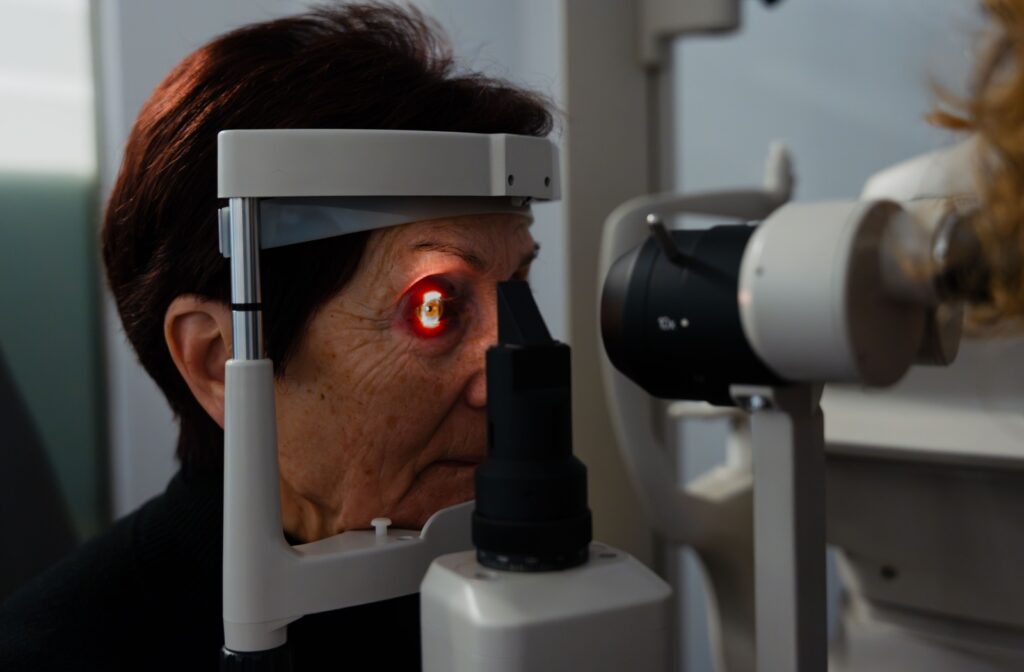People often assume that symptoms like blurry vision, duller colours, and difficulty while driving at night suggest that it’s time for new glasses. However, while challenges with your vision definitely call for a visit to your optometrist, updating your prescription lenses might not always be the right solution.
Eye diseases, like glaucoma and cataracts, all affect your eye health, but they can also cause distinct visual symptoms:
- Signs of cataracts might include foggy or hazy vision, dull colours, and difficulty driving at night.
- Depending on the type of glaucoma, common symptoms can include peripheral vision loss, headaches, or discomfort.
If you notice any changes in your vision, visit your optometrist right away. An accurate diagnosis helps determine the right course of treatment to protect your visual health.
Glaucoma: Symptoms & More
Glaucoma is an eye disease that damages the optic nerve, often due to elevated eye pressure. As glaucoma progresses, optic nerve damage gradually affects your peripheral (side) vision before affecting your central vision.
Here’s what makes glaucoma particularly challenging: it develops silently, often going unnoticed until it has already caused permanent damage. Since we can’t restore vision once it is lost, it’s crucial to schedule routine eye exams, as we can use these to detect changes in your optic nerve and eye pressure before you notice symptoms and take action accordingly.
Early Glaucoma Warning Signs
In its initial stages, glaucoma rarely produces noticeable symptoms. However, some people might experience:
- Subtle peripheral vision loss that develops gradually
- Mild eye discomfort or pressure
- Occasional headaches
- Difficulty adjusting to darkness
These early signs are often so mild that many people attribute them to fatigue or aging, which is why we strongly encourage older adults (65+) to have annual routine eye exams.
Advanced Glaucoma Symptoms
As glaucoma progresses, symptoms become more apparent:
- Noticeable loss of peripheral (side) vision
- Tunnel vision, where you can only see straight ahead
- Difficulty navigating stairs or curbs
- Bumping into objects at your sides
- Problems with night driving
Acute Angle-Closure Glaucoma
Glaucoma actually refers to a group of eye diseases that damage the optic nerve, and acute angle-closure glaucoma is one of these. Though less common than other types of glaucoma, this condition presents sudden, severe symptoms:
- Intense eye pain
- Severe headache
- Nausea and vomiting
- Blurry vision
- Halos around lights
- Red eyes
If you experience any of these signs, seek immediate medical attention. Acute angle-closure glaucoma can cause permanent vision loss within hours.

Recognizing Cataract Symptoms
As we age, the proteins in the lens of our eyes begin to break down, causing the lens to become cloudy. These cloudy patches are referred to as cataracts. Having cataracts is akin to looking through a foggy window—you might notice shapes and movement, but it’s difficult to make out colours and finer details.
Cataracts lead to noticeable, albeit gradual, changes in your vision (unlike glaucoma). Most people notice symptoms in their 60s, though they can develop earlier.
Early Cataract Signs
Initial cataract symptoms often include:
- Slightly blurry or cloudy vision
- Increased sensitivity to bright lights
- Difficulty seeing at night
- Colours appear less vibrant or slightly yellow
- Need for brighter light when reading
Updating your vision prescription can help improve some of these symptoms, but not for long. As cataracts advance, the lens becomes cloudier, leading to more pronounced visual changes.
Advanced Cataract Symptoms
In later stages, cataracts can cause:
- Severe vision impairment that affects daily activities
- Difficulty reading even with glasses
- Problems recognizing faces
- Trouble with stairs or uneven surfaces
- Complete clouding of the lens (mature cataract)
On the bright side, cataract surgery is straightforward and effective. Your ophthalmologist will carefully remove the clouded lens and replace it with an artificial one. This process is simple, quick, safe, and one of the most common eye surgeries.
Surgery normally occurs when the clouding caused by cataracts begins to meaningfully affect your day-to-day life.
Glaucoma vs Cataracts Symptoms: Key Differences
Symptoms are clues that help your optometrist accurately pinpoint the underlying cause of your concerns. While cataracts and glaucoma both affect the quality of your vision, their symptoms are distinct:
- Vision Loss Pattern: Glaucoma typically affects peripheral vision first, while cataracts cause overall vision clouding and dimming.
- Pain & Discomfort: Glaucoma usually doesn’t cause pain (except in acute cases), while cataracts may cause light sensitivity and glare issues.
- Onset Speed: Most glaucoma develops slowly over years, while cataracts also progress gradually, but with more noticeable symptoms.
- Reversibility: Glaucoma damage is permanent, but cataract surgery can restore clear vision.
Making a mental note of any symptoms can help you effectively communicate your concerns with your optometrist as they evaluate your overall vision and eye health.
Invest in Your Eye Health
While glaucoma and cataracts affect your visual health differently, they’re both manageable with early detection. Keeping an eye out for symptoms like blurry vision, headaches, and overall dullness are signs that should encourage you to visit your optometrist for a closer inspection. If it’s been a while since you’ve sat in an exam chair or you’re noticing unusual symptoms, connect with our EyeCare Niagara team to book an appointment. Your eyesight is irreplaceable; give it the care it deserves by staying on top of your routine eye exams.




